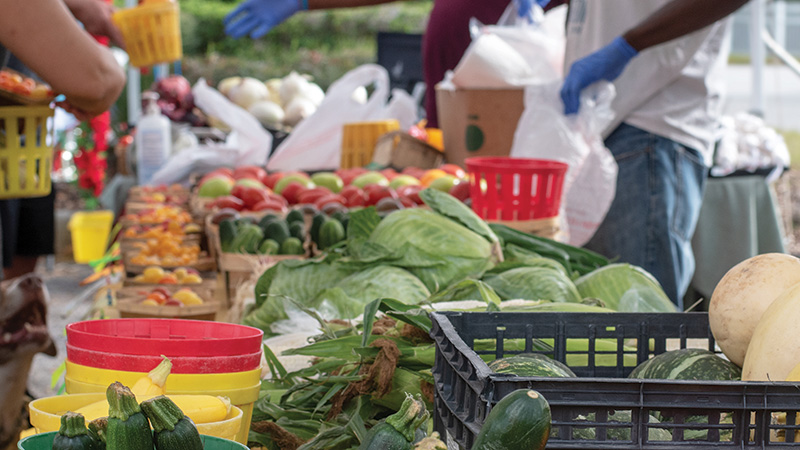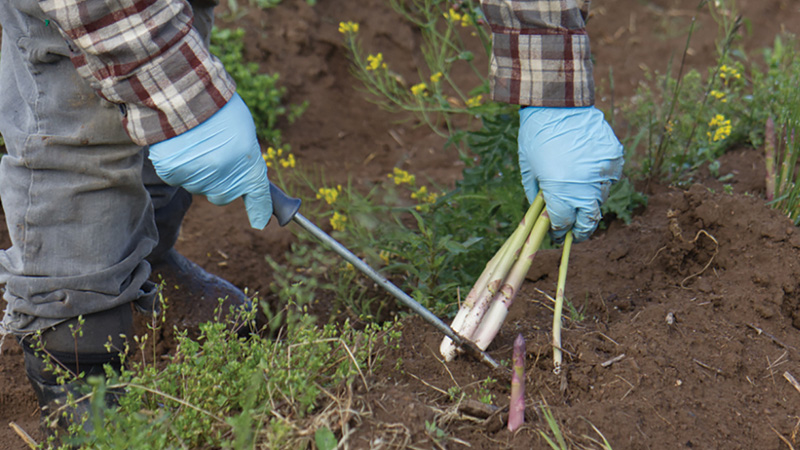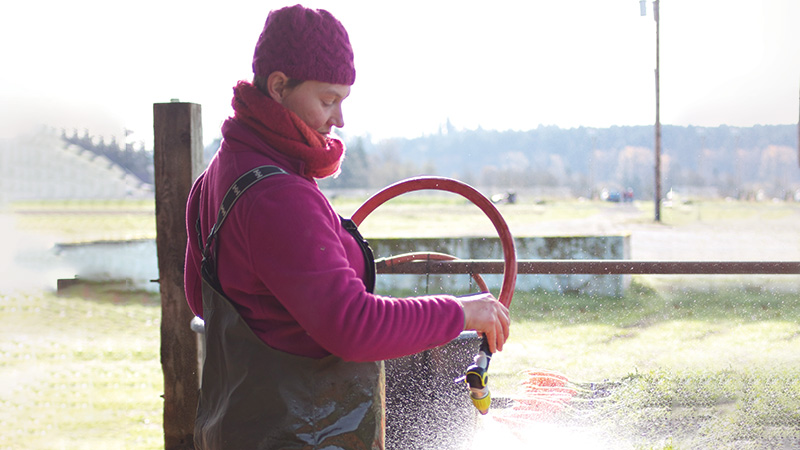Growing for Good
This article was originally published in March 2022

Kirsop Farm is celebrated at local farmers markets for its fat bunches of organic orange carrots, piled high on its stands. For years, the farmers have stocked their tables extra-abundantly, boxing up the remainder at day’s end for neighborhood food banks.
That connection expanded to entirely new levels with Growing for Good, a partnership between PCC’s member-supported food bank program, the Neighborhood Farmers Markets and the nonprofit group Harvest Against Hunger.
Fifteen Market farmers now supply fresh produce directly to 19 food banks. So far, 73,000 pounds of fresh produce have been purchased from local farms and gone directly to food banks. PCC members and customers have contributed $312,000 to date through PCC’s food bank program, and NFM has secured an additional $65,000 in support for 2022.
“It was wonderful to have a shift from just boxing up leftovers to, ‘Now I can pack for you exactly what you want or need,’ said Kirsop co-owner Genine Bradwin.
When Bradwin began early partnerships with local food banks, she told their managers the farm’s usual bestsellers: carrots, potatoes, fresh lettuces. Those crops, though, weren’t necessarily what was needed at every dropoff. Different food bank managers, depending on their clients and needs, asked if Kirsop could instead supply bok choy or green onions or peas, collard greens or mustard greens.
“That’s just wonderful. Because we sure can!” Bradwin said.
The feedback came early enough in the season that, with sales guaranteed, she could adjust which crops she planted and match the harvest with the wish lists.
“The people at the food bank are not always the same people that are shopping at the farmers market, and they want different things. Mustard greens and collard greens are very fun and easy for us to grow. If someone (with) a contract wants to buy them, it’s delightful for us,” she said.


Photos courtesy of Neighborhood Farmers Markets
Abrupt beginnings
The program originally grew from calamity. When the COVID-19 pandemic hit in spring of 2020, Seattle’s farmers markets were shut down while permitting agencies approved new operating plans. Between the closed markets and shuttered restaurants, farmers lost a huge percentage of their anticipated sales.
The Neighborhood Farmers Markets, which runs seven local markets, searched for ways to help mitigate the farmers’ losses. “They were in this period of really high uncertainty. We didn’t know when the markets were going to reopen,” recalled NFM Director Jennifer Antos.
A Market staffer reached out to Rachel Tefft, PCC’s community nutrition program manager, wondering if PCC might buy produce from Market farmers who had lost their usual sales outlets. The idea was “quickly explored and then quickly set aside,” Antos said. Few Market vendors produce enough to consistently stock PCC’s 15 stores, and they also work with different levels of regulations.
“The match wasn’t there for that. But Rachel came from the PCC food bank program, which has been running for 30 years, and said, “What if we used the donations from that to actually fund the purchase of food from these farmers?”
While it might have seemed unusual for the farmers markets to take up an outside program, NFM is concerned with anything that has a major effect on its participants.
“We have our broader mission, to strengthen and support Washington’s small family farms,” Antos said.
The food bank program was facing COVID restrictions at the same time. The dry goods that had been its hallmark could no longer be packaged and distributed under early COVID-19 regulations. Grocery rescue programs were hit by high demand from shoppers and a shortfall of volunteers, leaving food banks short on a donation source. Food bank clients needed fresh foods. Farmers needed a place to sell their crops.
PCC members and customers have contributed $312,000 to date through PCC’s food bank program
Every piece, ultimately, fit together. (Click here for a review of the program’s first few months.)
Another of the participants, farmer Manny Canales of Canales Produce, supplied food banks with fresh asparagus through the program—harvesting the crops after sleeping in his fields so he could protect the stalks from bad weather at a moment’s notice, as Tefft told PCC members at a recent meeting.
To see the food bank shelves look as inviting as the PCC produce department, stacked with fresh, firm emerald stalks from the Canales fields, seemed just the sort of program food bank donors wanted to support.
And while the program began as an emergency response, it’s also proving to make sense for the long term. Nonprofit partner Harvest Against Hunger proved another essential element of its success, providing administrative and practical support from managing contracts to handling delivery problems.
“One of the great things about this program is that the Food Bank and the farmer just work directly after that initial contract happens, so we are not in the middle of it,” Antos said.
“We’re not dictating what and when and how. Food banks can contact the farm and order what they need that week, while taking into account the room in their coolers, client needs and volunteer power. They decide what they want in a way that works for the farmer but is responsive to their community and operation.”
For Bradwin, the Kirsop farmer, there’s no question about the benefits.
“It does two good things, not just one,” she said.
“It accomplishes the goal of providing food for someone who’s hungry, but then it provides this other benefit of supporting the farmer (through guaranteed sales). It’s just a great way to get a lot more for the money.”
